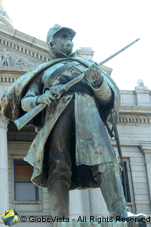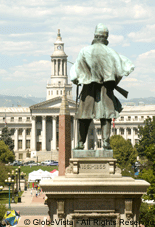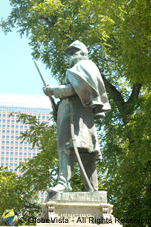Denver Civil War Monument

Public Art: Denver Civil War Monument
Artist/Sculptor: © modeled by Swiss sculptor J. Otto Schweizer.
Designed by: Captain John D. Howland
Date: Unveiled on July 24, 1909.
Description: The Denver Civil War Monument features a bronze figure of a Union Soldier facing South with a gun in hand standing atop a stone base. The stone base is adorned with four tablets which list the battles and the names of the soldiers who died during the Civil War.
Chiseled into the base is also a statement proudly proclaiming that Colorado had the highest average of volunteers in the Civil War of any state or territory in the Union. Yet another plaque on the base refers to the discovery of gold at Pikes Peak in 1858 by Green Russell and others. The final plaque simply reads, ” For the Unknown Dead.” Located on stones at the foot of the statue is a plaque referring to the tragic Sand Creek Massacre, see inscription below.

Location: The west entrance of the Colorado State Capitol building, Denver, Colorado, United States.
Funded by: Donations from both the taxpayers and the Colorado Pioneer’s Association.
History: Captain John D. Howland was commissioned to complete the Civil War Monument in 1908. Howland was a member of the 1st Colorado Cavalry and an accomplished artist who had studied in both Europe and Mexico. His teacher and mentor was Armand Dumeresq (secretary to the Indian Peace Commission). The names of the dead soldiers weren’t added to the base until the 1920s.
Controversial Inscription :
The controversy surrounding this Civil war Monument has become a symbol of Colorado’s struggle to understand and take responsibility for our past. On November 29, 1864, Colorado’s first and Third Cavalry, commanded by Colonel John Chivington, attacked Chief Black Kettle’s peaceful camp of Cheyenne and Arapalio Indians on the banks of Sand Creek, about 180 miles southeast of here.
In the surprise attack, soldiers killed more than 150 of the village’s 500 inhabitants. Most of the victims were elderly men, women, and children.
Though some civilians and military personnel immediately denounced the attack as a massacre, others claimed the village was a legitimate target. This Civil war Monument paid for by funds from the Pioneers’ Association and the State, was erected on July 24, 1909, to honor all Colorado soldiers who had fought in battles of the Civil War in Colorado and elsewhere. By designating Sand Creek a battle, the monument’s designer mischaracterized the actual events. Protests led by some Sand Creek descendants and others throughout the twentieth century have since led to the widespread recognition of the tragedy as the Sand Creek Massacre.
This plaque was authorized by Senate Joint Resolution 99-017

Things You May Not Know:
Rumor has it that some of the men listed on the Civil War plaques didn’t actually die in battle, in fact, some deaths weren’t even military related. Among the causes of death included; firing squad (I presume treason?); death by pub brawl; and several deaths from diseases which were not military related (I don’t want to know). The problem, it seems, was the committee had to purchase the list from the daughter of Colonel George Shoup and when they finally got the list they didn’t bother to check it. (Thank you Mindy Elswick and Denver Post).
Controversy Sweeping the States: This statue, among many others throughout the United States, has been targetted for removal. Many argue that it glorifies soldiers who killed and massacred American Indians.
Here lies one of the issues, Colorado sent 4,903 soldiers to fight for the Union during the Civil War. On the plaque, it lists the 22 battles they fought. Of those battles, 4 were not against the Confederates but against the American Indians. The last battle mentioned, was, in fact, a massacre known as the Sand Creek Massacre led by Chivington. The statue of the soldier has often been mistakenly thought to be that of Col. John Chivington.
In 1998 Colorado Senator Bob Martinez was instrumental in unanimously passing through a bill to have Sand Creek removed from the list of battles. Despite this, it was never removed but instead, an additional plaque was added.
In joining the debate Cheyenne and Arapaho tribal representatives said it is better to recognize what actually happened than erase the past.
A memorial to those who lost their lives at the Sand Creek Massacre is soon to be erected on the grounds of the Capitol Building.